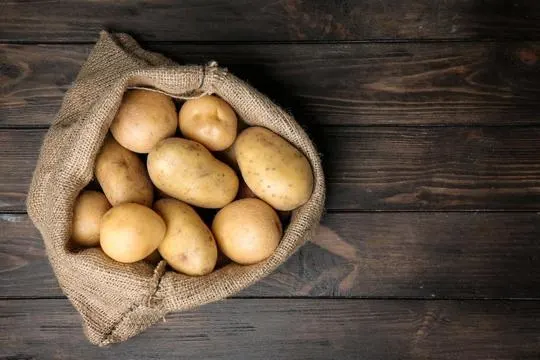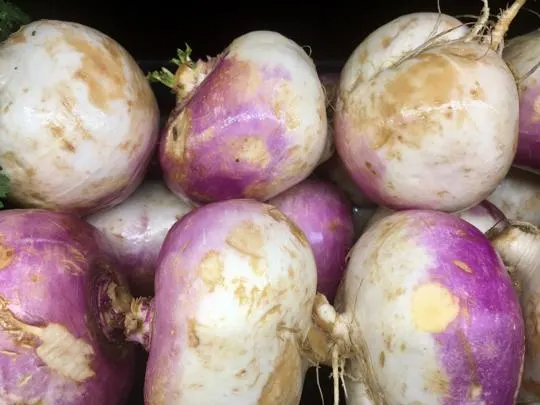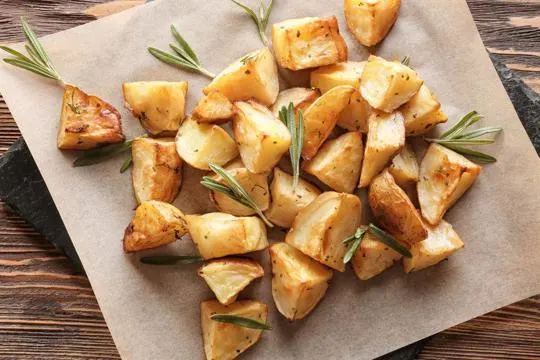Summary of key points
Potatoes and rutabagas may look similar, but they have a few key differences. Potatoes are starchy and have a mild flavor, making them versatile for various dishes such as mashed potatoes or fries. Rutabagas, on the other hand, have a sweeter, earthier taste and are less starchy, making them better suited for roasting or adding to soups and stews. Additionally, rutabagas are higher in nutrients like vitamin C and potassium compared to potatoes. Whether you’re cooking for taste or health benefits, both are delicious options for incorporating into your meals. Try experimenting with different recipes to see which root vegetable you prefer!
Ever been in the kitchen, ready to whip up a masterpiece, only to stare down at a potato and a rutabaga and wonder, “What on earth is the difference?”
We’ve all been there, mixing them up like it’s some culinary mystery we were never taught to solve.
Here’s the lowdown: potatoes are the familiar comfort food we all love. Fries, mashed, boiled – you name it, we’ve tried making it.
Rutabagas? They’re like the distant cousins that show up at family functions, and you’re not quite sure what to do with them.
Yet, here we are, ready to crack this case wide open.
With a mix of curiosity and a dash of humor, we aim to clear up the confusion.
What is a Potato?

Potatoes are a must-have veggie all over the world.
They are part of the Solanaceae family and have a starchy texture, plus a yummy taste.
You can find them in various shapes, sizes, and even colors like red, yellow, white, and purple.
Plus, they’re full of vitamin C, potassium, and fiber.
Potatoes have a high water content, which gives them a moist texture when cooked.
This makes them good for boiling, steaming, mashing, or frying.
Plus, their neutral flavor goes well with other ingredients.
Think French fries, mashed potatoes, and potato salads.
You can even classify potatoes based on how they cook.
There are waxy potatoes, perfect for roasting and salads.
And there are mealy potatoes, which make fluffy mashed potatoes.
Potatoes have even shaped history.
Indigenous people in South America first cultivated them over 7,000 years ago.
Then, they spread to Europe during the Columbian Exchange.
Now, they’re one of the most popular crops in the world.
When shopping for potatoes and rutabagas (a root vegetable like turnips), remember each one has unique qualities and flavors.
Whether it’s the smoothness of Yukon Golds or the earthiness of Fingerling potatoes, these tubers will add a tasty touch to your meal.
What is a Rutabaga?

Rutabagas, also known as Swedish turnips or neeps, are a root veg from the cabbage family.
They’re larger than potatoes and have a yellow-brown outer skin and pale orange flesh.
These root veggies have a slightly sweet and earthy flavor, making them ideal for a variety of cooking methods.
Rutabagas are full of essential nutrients.
They have Vitamin C, fiber and potassium, and are low in fat and calories.
Enjoy them roasted, boiled, mashed, or added to soups and stews for flavor and texture.
What sets rutabagas apart is their unique taste.
While potatoes are mild, rutabagas have a robust, slightly sweeter flavor.
They also have a firmer texture that helps them retain their shape and hold up better during longer cooking times.
On top of being delicious, rutabagas offer numerous health benefits.
The fiber supports digestion and satiety, the Vitamin C bolsters immunity, and the antioxidants reduce inflammation.
So, if you’re looking to expand your culinary horizons or try something new, give the humble rutabaga a go.
Differences Between Potatoes and Rutabagas

Potatoes and rutabagas may look similar. But they have key differences.
Origin and Botanical Classification
Potatoes and rutabagas are distinct in their origin and botanical classification.
Potatoes are part of the Solanaceae family while rutabagas are part of the Brassicaceae family.
Potatoes, or Solanum tuberosum, come from South America.
It was cultivated by indigenous people there thousands of years ago.
Explorers then brought it to Europe where it became popular.
Rutabagas, or Brassica napus var.napobrassica or Brassica napus var.rapifera, originated from Europe.
They are believed to be a creation of turnips and wild cabbage species.
Rutabagas are appreciated for their nutritional value and versatility in cooking.
Both potatoes and rutabagas are classified as angiosperms.
This means they reproduce through flowers and bear seeds enclosed in fruits.
Appearance and Texture
Potatoes and rutabagas may seem similar.
But, when you look closer, their looks and feels are unique.
Potatoes have thin, smooth skin that can be white, yellow, or red.
Rutabagas have a rough outer layer and a purple or tan shade.
Potatoes are soft and starchy when cooked.
They’re great for mashing or baking.
Rutabagas are firmer and have a sweet and nutty taste.
Roasting or stewing them is the way to go.
So, though both veggies can be on your plate, they differ in flavor and cooking.
Taste and Flavor
Potatoes and rutabagas have different flavor profiles.
Potatoes are known for their mild and earthy taste.
Rutabagas have a sweet and nutty flavor.
Potatoes are smooth and creamy, whereas rutabagas are dense and firm.
Potatoes can be boiled, baked, mashed, or fried to create varying flavors.
They are naturally sweet, making them perfect for french fries or potato chips.
But they also work great in savory dishes like mashed potatoes or potato salad.
Rutabagas add an earthy flavor with a hint of sweetness.
Delicious in stews and soups, rutabagas also add flavor to roasted vegetables and gratins.
Both potatoes and rutabagas can be enjoyed in various forms.
From comforting mashed potatoes to hearty rutabaga soups, these root veggies provide deliciousness and nutrition.
Potatoes offer vitamins C and B6, potassium, and fiber.
Rutabagas are rich in vitamin C, iron, calcium, and potassium.
Nutritional Composition
Taters and rutabagas aren’t the same nutritionally.
Potatoes have more carbs, which give you energy fast.
They also have more vitamin C, which helps your immune system.
Rutabagas have more calcium and potassium, which is great for bones and blood pressure.
Both of these veggies offer special nutrition, so include them in a balanced diet.
Similarities Between Potatoes and Rutabagas

Potatoes and rutabagas may be different, but they do have some similarities.
Both are root vegetables in the brassica family, and have the same texture and appearance.
They also have high starch content and offer nutrients like potassium and vitamin C.
But they are unique too.
Potatoes come in various colors and have different flavors and textures.
Rutabagas have a sweet flavor and a dense texture when cooked.
Plus, they have a purplish-brown skin that sets them apart from potatoes.
Next time you’re at the grocery store, remember these similarities and differences.
Then you can choose the right veggie for your recipe.
Culinary Uses of Potatoes and Rutabagas
Potatoes and rutabagas – two versatile ingredients.
Potatoes are great for frying, boiling, mashing, or baking.
French fries, mashed potatoes, and potato gratin are all good examples.
Rutabagas have a slightly sweet, earthy flavor.
Roast or boil them and add to soups or stews.
Try mashing or using in casseroles for a unique twist.
Both potatoes and rutabagas offer endless culinary possibilities.
Comfort food or new flavors – it’s up to you.
Cooking and Preparation Differences
Cooking potatoes and rutabagas requires different methods.
Potatoes are very versatile.
Boiling, frying, baking and mashing all work.
And when cooked, the flesh becomes fluffy – perfect for many dishes.
Rutabagas have a denser texture and a sweet flavor.
Roasting or steaming are best ways to bring out this sweetness.
They make a great substitute for potatoes in some recipes, adding a unique twist.
Conclusion
As you can now see, the differences between potatoes and rutabagas are fairly pronounced and should be considered when one is deciding which of these vegetables to use in their recipes.
While both of them offer delicious cooking options with various dishes, they differ in terms of texture, taste, nutrition, and color.
Their unique flavor profiles and textures make them perfect for an array of dishes, but it’s important to keep in mind the other features when deciding which one fits best for your needs.
Both vegetables have their unique advantages, so it’s up to you to decide which one will bring out the best flavors in your recipe.
So don’t hesitate – get cooking with either a potato or a rutabaga.

Leave a comment